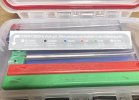Powered grinding can easily burn the very apex of the edge. Delta protocol is more sensitive to this than most. It does not take much to lose the structure that gives us the properties that we want at the very leading edge which is where it really counts.
I do sharpen powered, but the belt is moving slow enough you can read it, and it is dripping wet. Places that sharpen with powered grinders will tell you "don't worry the edge doesn't even get hot". They don't know wtf they're talking about.
I did the math once and I found that you could raise the temperature of the leading .005" edge to 1,000° and it would cool off into the blade before you could touch it and it would not raise the temperature of the blade by 1° . You would never know that you burned it, and you wouldn't understand why your edge retention isn't right.
So I strongly encourage people do not use powered grinding on Delta 3V. I do it, but I'm doing this in production. I'm doing it at low speed and under flood coolant. Most places doing powered sharpening are not doing it right. And it's perfectly fine for a production knife with a shit heat treat, but you do not want to subject a CPK to that.


